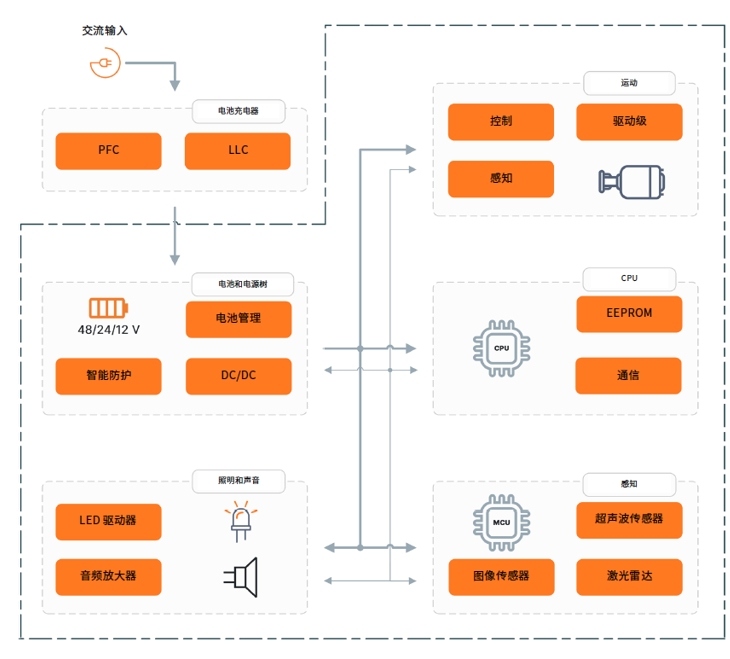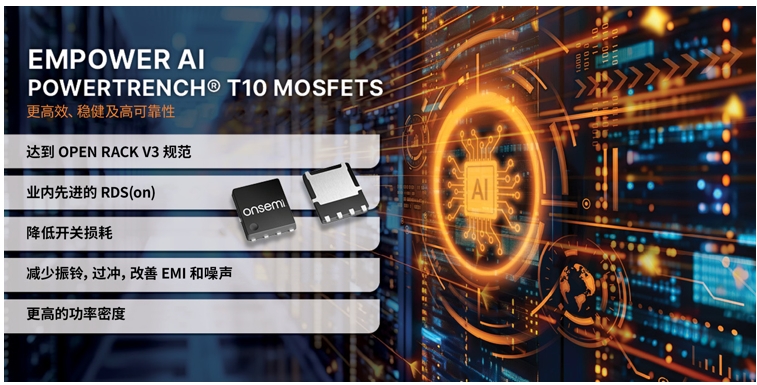Source: ON By Theo Kersjes, Systems Engineering Manager
Autonomous mobile robots (AMRs) are complex systems that have much in common with autonomous vehicles - they require perception, motor drive, power conversion, lighting, and battery management. Perhaps the biggest challenge is to integrate these subsystems into one final product - a challenge made more difficult by the need to integrate different subsystems from different vendors.
This article will explore the complex world of AMR and consider choosing one solution provider to take care of all key aspects of AMR's design - benefits that include reduced design/integration risk and reduced time to market.
Whereas an autonomous guided vehicle (AGV) operates primarily indoors and follows a pre-determined route (often using lines on the ground as guidance), an autonomous mobile robot (AMR) is much more complex, able to navigate both indoors and outdoors freely without having to follow a pre-defined route. In this respect, they are similar to autonomous vehicles in that they must recognize and avoid obstacles in their path, whether stationary or moving.
At the heart of almost all AMRs are five main subsystems that manage power, motion, perception, processing, and lighting. Each subsystem is inherently complex, often challenging to design, and fundamental to the successful operation of AMR. However, integration is often the biggest challenge - especially when purchasing subsystems or major components from different suppliers.

Build the AMR for system integration
Perception is crucial for autonomous mobile robots (AMRs) navigating in free space, especially when no tracks or other navigational AIDS are available. AMR must be able to find a safe route and deal with static and moving obstacles in its path. To overcome the limitations of weather or lighting conditions and to adapt to different distances, a variety of technologies including image sensors, ultrasound and LiDAR are used. Data from multiple sensors is combined to better understand the surrounding environment. This technique is called sensor fusion, and it provides better reliability, redundancy, and security.
Onsemi has been a leader in intelligent perception technology. On offers a wide range of roller-exposure and global exposure image sensors from VGA to 45 megapixels. These sensors offer industry-leading performance in dynamic range and innovative features such as motion wake-up and automatic exposure control. In addition to image sensors, On offers silicon photomultiplier tubes (SiPM) for ranging (LiDAR), ultrasonic sensors, inductive sensors, and Bluetooth sensors that support Angle of arrival (AoA) and Angle of Departure (AoD). Low Power (BLE) technology microcontrollers, these can be used for positioning.
Motion control is very important in AMR. Brushless direct current (BLDC) motors are commonly used and require complex algorithms for precise control. The brushless DC motor drive stage requires many components to be properly controlled. The NCD83591 three-phase gate driver controls commutation by turning power switches on and off, making it ideal for use in motor control subsystems.


Another advantage of SiC MOSFETs is the ability to operate at higher temperatures, which simplifies heat sink design. Higher operating frequencies reduce the size (and cost) of magnetic components, thereby reducing the size of the subsystem and helping to expand the AMR's operating range.
Power delivery is not only crucial for motor control. The system also requires an external charger, which needs to charge the battery as quickly and efficiently as possible. The DC-DC power tree in AMR uses switch-mode power supplies (SMPS) and linear voltage regulators (LDO) to supply logic and low voltage levels. Efficiency is important, but so is the deployment of appropriate protection measures throughout the power supply architecture. On Semiconductor offers a range of electronic fuse (eFuse) and SmartFET solutions for AMR applications.
Communication is critical to AMR, both within the AMR itself and externally with supporting facilities, and possibly with other AMRs. Parameters to consider when selecting a communication technology for AMR include its operating range, data transfer rate, power consumption, and security. For internal communication, a number of protocols have long been used, including CAN, LIN, RS-485, and RS232. Ethernet 10BASE-T1S (such as On's NCN26010) are gaining popularity for their combination of simplicity and high performance. It provides all the physical layer functionality needed to send and receive data over a single unshielded twisted pair. Communication with the main control MCU is carried out through the OPEN Alliance MAC-PHY Serial Peripheral Interface (SPI) protocol.
Whether sending routing or configuration information and reporting location and progress, or for real-time location services (RTLS), external communication is also essential for AMR. On's RSL15 ultra-low Power Arm based on Bluetooth LE 5.2 Wireless MCU? Cortex? The M33 processor is ideal for real-time positioning systems (RTLS) using Angle of Arrival (AoA) and Angle of Departure (AoD) capabilities, and it can also be used to connect smart devices. With built-in power management, a wide supply voltage range, flexible GPIO and clock circuits, and a wealth of peripherals, the RSL15 gives AMR designers maximum design flexibility.
The lighting subsystem is used to communicate the AMR's status, condition, and intent to nearby people and other AMRs. Performance characteristics and parameters to consider when selecting AMR lighting technology include brightness, color temperature and power consumption. LED controllers and drivers monitor the current flowing through the LED and cause the LED to emit light of a specific intensity and wavelength. The LED driver circuit uses high-voltage and low-voltage power MOSFETs to turn the LED current on and off, while preventing overvoltage and overcurrent conditions and ensuring the stability of the LED driver circuit.
Support for AMR solutions
Choosing a solution provider can be a risky decision, but they have a comprehensive set of product solutions. Equally important is the support provided throughout the design process and the ability to deliver the product when and where it is needed.
As an established supplier with extensive industry experience, On is able to provide system-level application support. Our global network of sales and technical teams can provide front-line support regardless of region, time zone or language.
In addition to on-site support, users can also access our online technical support center. The On Community Forum is an online developer community where experienced users of On products can share their extensive knowledge about products and applications. Users can access the forum through a number of subject-specific product forum areas to interact with industry peers and ask or answer questions. The help library is also a good place to learn frequently Asked questions (FAQs) and answers. For users who prefer more interaction, AI-powered chatbots can provide you with answers in seconds.
On offers a wide range of free self-service Tools, including interactive block diagrams, Product Recommendation Tools+TM product recommendation tools and a large number of evaluation boards/kits to facilitate rapid prototyping. Power electronics designers will find these simulation tools useful. Elite Power Simulator simulation tools and self-service PLECS model generation tools not only improve accuracy by modeling real-world component performance, but also speed time to market.
Of course, all of this is only valuable once the product has been designed and put into production. On's dual internal and external manufacturing capabilities increase supply chain resilience and improve supply security.
Conclusion
AMR is growing in popularity as an efficient and reliable way to deliver packages and perform other logistics tasks. However, fully autonomous driving requires a high degree of complexity and safety, no different from that of a car.
Perhaps the biggest design challenge is not the various subsystems in AMR, but the integration of those subsystems, especially if those subsystems come from different vendors, whose compatibility is likely to be a challenge.
As a solution provider, On is unique in offering a complete set of highly advanced products for the design of AMR, as well as a comprehensive support ecosystem including support staff, tools, documentation, online forums, and more, backed by vertically integrated resilient manufacturing capabilities.
免责声明: 本文章转自其它平台,并不代表本站观点及立场。若有侵权或异议,请联系我们删除。谢谢! Disclaimer: This article is reproduced from other platforms and does not represent the views or positions of this website. If there is any infringement or objection, please contact us to delete it. thank you! |


